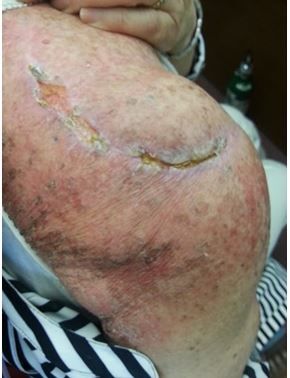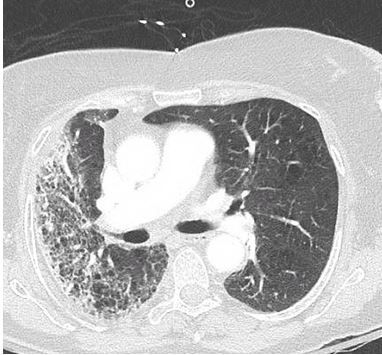- Clinical Technology
- Adult Immunization
- Hepatology
- Pediatric Immunization
- Screening
- Psychiatry
- Allergy
- Women's Health
- Cardiology
- Pediatrics
- Dermatology
- Endocrinology
- Pain Management
- Gastroenterology
- Infectious Disease
- Obesity Medicine
- Rheumatology
- Nephrology
- Neurology
- Pulmonology
Acute Radiation-Induced Pneumonitis
Figure 1 (click to enlarge)

Figure 2 (click to enlarge)

An 84-year-old woman presented to the ED with progressive dyspnea and hypoxemia. Her oxygen saturation was 84% on room air and the rest of her vital signs were within normal limits. She said she has had a dry, nonproductive, hacking cough for the past few months without hemoptysis. She denies any chest pain, syncope, fevers or chills, and has no recent travel history and no sick contacts.
Her past medical history was significant for squamous cell skin cancer of the right shoulder which was treated with surgical excision (Figure 1) followed by 7 weeks of radiation therapy. Results of a CT scan of the chest are seen in Figure 2.
1. What is your diagnosis based on the skin lesion and CT chest findings shown?
2. What are the treatment options?
Answers
1. Radiation-induced lung injury after radiation therapy to the right shoulder for squamous cell skin cancer.
Incidental radiation-induced lung injury is often dependent on dose of radiation and is generally unavoidable. Acute radiation pneumonitis may develop and can present with a dry cough and dyspnea. Pulmonary fibrosis can also cause dyspnea, but is the late complication. Radiographic imaging and pulmonary function testing can help identify the degree of lung injury.
2. Reduce inflammation.
When clinical radiation-induced lung injury is suspected, the mainstay of therapy is to reduce inflammation. In more symptomatic patients glucocorticoids are indicated. The recommendation for initial treatment is to begin prednisone at 1 mg/kg. The initial dose is continued for several weeks with a slow taper to avoid exacerbation of symptoms.
References:
- Movsas B, Raffin TA, Epstein AH, Link CJ Jr. Pulmonary radiation lung injury. Chest. 1997;111:1061-1076.
- Morgan GW, Breit SN. Radiation and the lung: a reevaluation of the mechanisms mediating pulmonary injury. Int J Radiat Oncol Biol Phys. 1995;31:361-369.
- Nieder C, Jeremic B, Astner S, Molls M. Radiotherapy-induced lung toxicity: risk factors and prevention strategies. Anticancer Res. 2003;23:4991-4998.
- Park KJ, Chung JY, Chun MS, Suh JH. Radiation-induced lung disease and the impact of radiation methods on imaging features. Radiographics. 2000;20:83-98.
